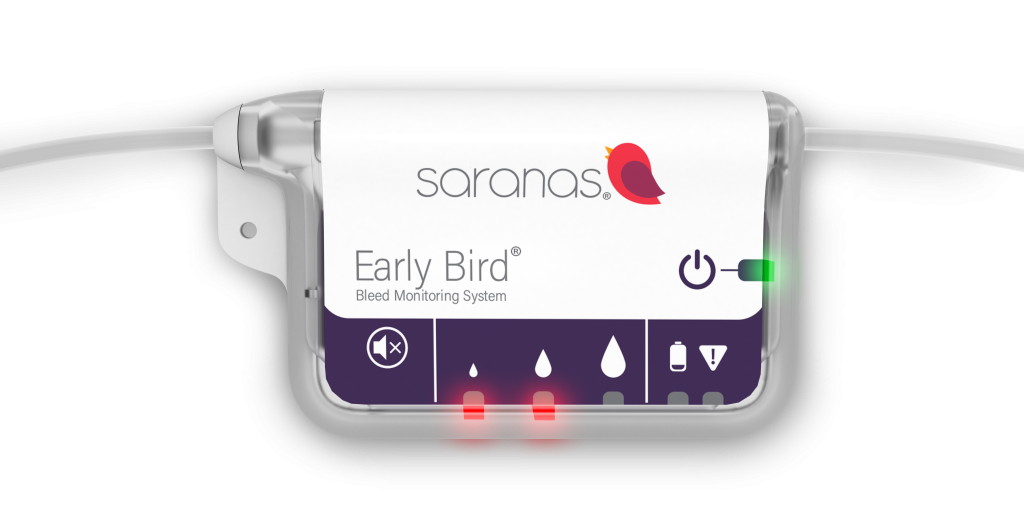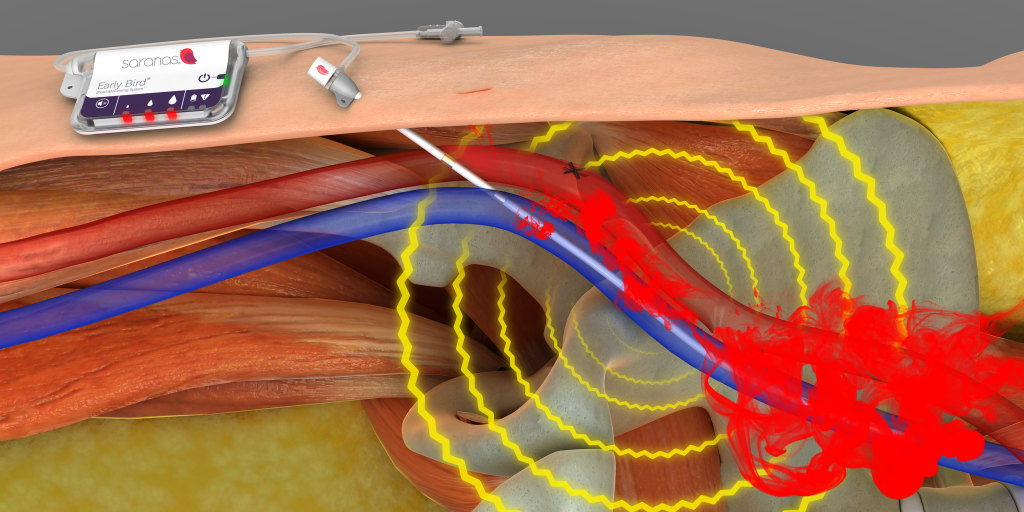Deborah Introduces a New Standard of Care to Reduce Major Bleeding
Like a “Mini CT Scanner,” the Early Bird ® Bleed Monitoring System Continuously Monitors for Bleeding 12 Hours Post-Procedure

Deborah Heart and Lung Center recently deployed the Saranas Early Bird ® Bleed Monitoring System, following interventional cardiac procedures requiring “large bore access” (which describes the size of the catheter inserted during a minimally-invasive procedure). Deborah is the first to bring this new technology to South Jersey. Certain minimally invasive procedures such as transcatheter aortic valve replacement (TAVR), or insertion of the Impella or balloon pumps, require large bore catheters inserted into the femoral artery for access. Insertion of a catheter into an artery or vein is always associated with the potential for bleeding. As the size of the catheter inserted into an artery increases, so does the bleeding risk.
The Early Bird is a small, venous sheath (catheter) embedded with an electronic tissue impedance monitoring system. This sheath is advanced into the femoral vein adjacent to the large bore arterial sheath to monitor for bleeding during the procedure, and up to 12 hours following the procedure. Any bleeding which occurs around a vascular sheath is associated with a change in electrical impedance through the tissue. It is this “bio-impedance” which is continuously monitored by the Early Bird system. Changes in bio-impedance can be detected by this device long before it is becomes clinically evident, even on close physical examination. If monitoring is necessary for longer than 12 hours, the device can be easily changed out for a new system over a guide wire.

“This is a great addition to our arsenal ensuring safe patient outcomes,” said Richard Kovach, MD, chair of Interventional Cardiology at Deborah Heart and Lung Center who, along with Daniel Ice, MD (interventional cardiologist) and Paul Burns, MD (Chair of Cardiothoracic Surgery) were the first to use this device. “Although we routinely perform complex endovascular and minimally invasive procedures with large bore access in our hybrid operating room and catheterization laboratories, procedure related bleeding always remains a potential complication. Early detection is critical in preventing a very small bleed from becoming a major complication.”
Dr. Kovach added: “One in five patients who undergo a procedure requiring large bore arterial access is at increased risk for post-procedure bleeding. This can occur quickly and may often not be clinically evident until a very large amount of blood has been lost. Not infrequently, by the time the bleeding has been discovered, the patient may have developed a very large hematoma, bleeding in the pelvis, or significant drop in blood pressure, requiring transfusion or vascular intervention and repair. Management of a large bleed may not only require urgent transfusion and aggressive management in an ICU setting, but typically also results in a significant increase in the length of hospital stay, and can even have an impact on long-term mortality.”
The Early Bird sheath has a 3-staged visual and auditory alarm system. The three stages correlate with small, medium, and large bleeds. A Level 1 alarm correlates with fairly mild bleeding, which can be managed easily with prolonged manual compression. The obvious goal is to intervene before reaching stage II or stage III.
“Of the first three devices inserted at Deborah Heart and Lung Center, two generated a Stage I alarm within one hour after the procedure, and both patients were easily and properly managed,” said Dr. Kovach. “It is obviously far better to discover a bleeding issue very early on, avoiding major bleeding complications and transfer back to the ICU, operating room, or catheterization laboratory for more aggressive management.”
He noted: “Even if a large-bore device has not been used for arterial access, the Early Bird system may be useful in other patients at increased risk for bleeding post procedure, such as those who are morbidly obese, exceptionally frail, have very diseased or noncompliant vessels, or have very low platelet counts related to chemotherapy or other diseases.”
“We are thrilled to be able to offer this new technology to our patients. Anything we can do to improve outcomes and reduce risk is a win-win for all.”
Deborah Heart and Lung Center in Browns Mills, NJ is an 89-bed teaching hospital that specializes in the prevention, diagnosis, research, and treatment of heart, lung, and vascular diseases. Founded in 1922, Deborah has been a regional and nationally recognized leader throughout its 100-year history, during which time it has healed 2.3 million patients from every corner of the United States and 87 countries in the world. From performing the first open heart surgeries (adult and pediatric) in New Jersey, to running one of the highest volume left-ventricular assist device (LVAD) implant programs in the region, Deborah has stood at the forefront of medical innovation, all while never wavering from its founding mission “there is no price on life.” Deborah is consistently recognized as a leader in patient care from the Centers for Medicare and Medicaid Services, ranked among the top hospitals in New Jersey for patient satisfaction; holds a top-tier Society of Thoracic Surgeons rating which places Deborah among the best cardiac surgery programs in the country; and is designated a national Top Teaching Hospital by The Leapfrog Group. Deborah is an Alliance member of the Cleveland Clinic Heart, Vascular & Thoracic Institute.